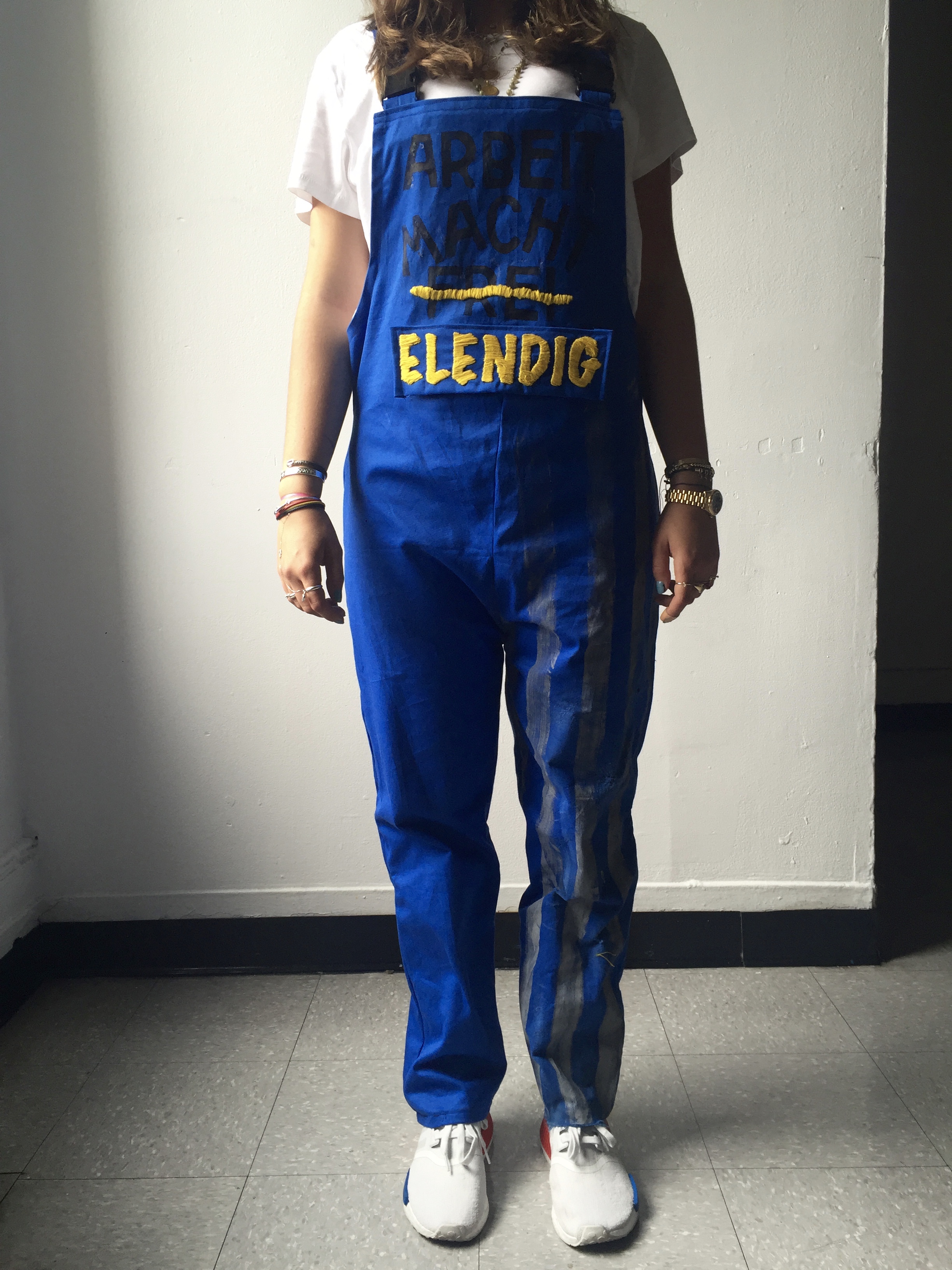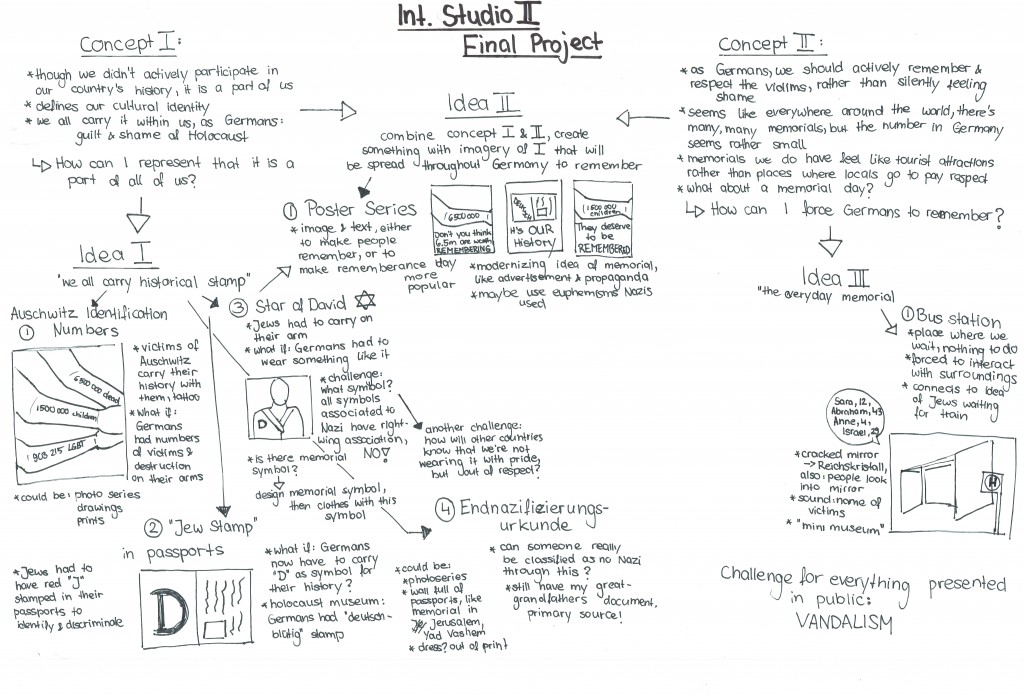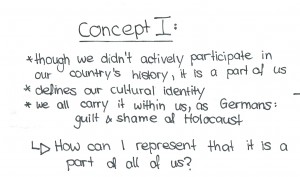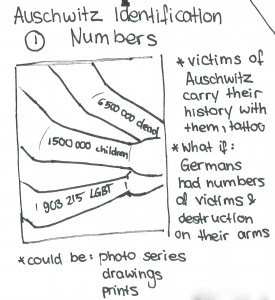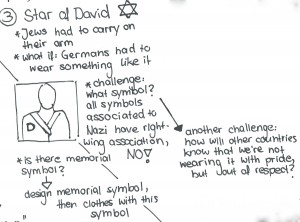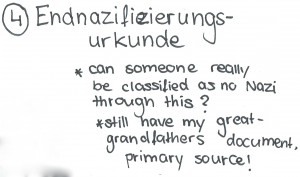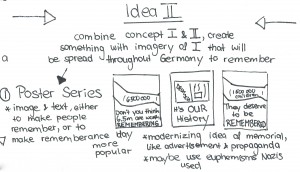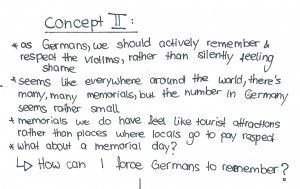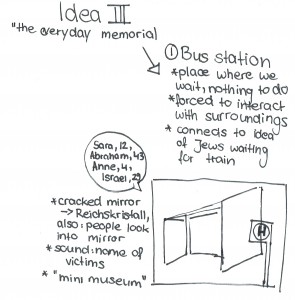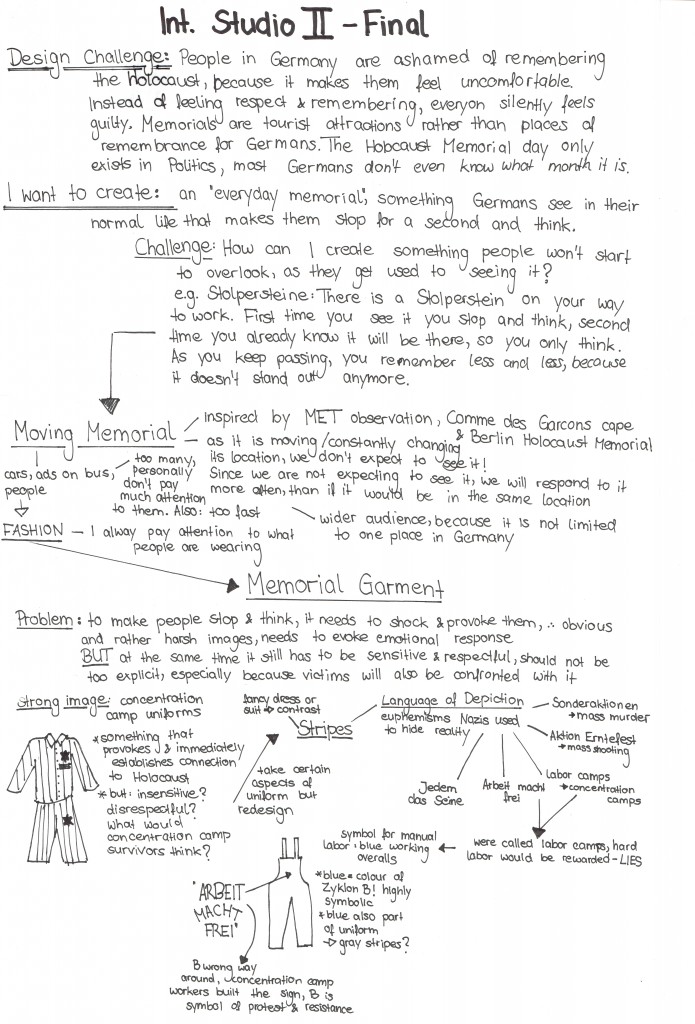Ideas
For my final studio project, I do not yet have a concrete idea of what exactly it is that I want to create, but I rather have two concepts in mind, which I would either try to combine, or I’d choose one from, leaving me with three broad ideas.
Idea 1:
The first idea connects to the concept of how our identity is shaped by our context, and therefore also by our country’s history. Even though we usually don’t even first hand experience these moments in history, they become part of what it means to be from that country. Germany is probably one of the best examples for this phenomenon. Though I never actively participated in any World War 2 activities, and never once had a Nazi thought crossing my mind, I feel responsible for what my granddad, my great-grandad and all my other ancestors, as well as my other countrymen, have done to Jews, the disabled, homosexuals etc.
I’ve had several ideas to represent this:
1) To use the number Jewish prisoners in the Auschwitz concentration camp had tattooed on their arm. By having this on their arm, they are remembered of the brutal images and memories every single day. What if instead of the Jewish victims of persecution, Germans had something like this to remind them of the horror of their country? Like a warning sign to say make sure this does not happen again, as well as a reminder to respect and remember the victims of the holocaust.
My idea would be to recreate this number, but have the numbers of the victims tattooed on German arms, preferably on older arms. With this image, I could do a photo series, drawing the number on the arms with nonpermanent color, but in a way that makes them look authentic like the concentration camp numbers. I could do either just a cropped image of the arm, or show more of the person photographed in order to really put across the idea that they are German, so that they are not the victims, but rather the prosecutors.
Alternatively to a photo series, I could try to represent this idea through either drawings, or with other media such as print making. I’ve always wanted to try printmaking, but never have, so that is a medium I would love to explore.
2) During World War 2, all Jews had a big, red stamp in their passports declaring them as Jews. Passports of Jewish people who did not have that J were classified as invalid. However, passports with the J inside were as invalid, as Jews did not have any rights in Germany during World War 2. A thought that crossed my mind was what if Germans had a stamp like that in their passports, declaring them not only as Germans, but as the generations after the second World War. This stamp would represent Germany’s history and mistakes. Stamp designs could either be a large red D or G for the word German, or the word “deutschbluetig.” When visiting the Holocaust Memorial Museum in New York, I learned about all the different stamps and classifications that existed, and found out that “deutschbluetig” (of German blood) was the official stamp used to classify Germans.
Taking this image of a passport with the stamp inside, I could again create a photo series, or something else I have thought about is creating something like the Yad Vashem hall of remembrance, where hundreds of portraits of victims are shown. This idea os repetition could then also be applied to a dress or a different piece of clothing ( -> Comme des Garcons dress at the MET, walking Berlin Holocaust memorial).
3) Star of David on clothes
4) Endnazifizierungsurkunde
Idea 2:
My second idea connects the concepts of idea 1 and 3, which are the idea of everyone carrying history as part of our identity and the concept of an “everyday” memorial for Germans to pay their respects and to remember.
To do this, I would try to use the images of Idea 1 and create posters with a political message out of them, that will serve as little memorials spread throughout the city. To make the posters stand out from the overstimulation of advertisements and propaganda posters we find ourselves surrounded by, and to at the same time put the poster into context, I thought about recreating the vintage look that posters had back in the time of world War 2. A method to do this could be to explore printmaking and stamping.
These posters have to appeal to emotions and have to be shocking, therefore both imagery and texts have to be wisely chosen. An element that would be interesting to look at is the language and the euphemisms Nazis used to describe their horrible acts.
Challenges that I see in this project are that posters are so easily overlooked, especially once we grow familiar to them. For me to really pay attention to a poster, I have to be forced to be opposite of the poster and to look at it for a while. I find that when walking past posters, I rarely really look at them. However, if I’m looking outside of my apartment window or sitting on the train and seeing a poster on the other side, I will look at it more closely and will really learn to appreciate it. The placement of the posters would therefore be an essential element. Another problem is that posters are often times not really associated with worth and value, so I’m still asking myself whether or not it is a respectful form of remembering or not.
Idea 3:
When looking at the way Germany handles the whole topic of the Second World War, it always frustrates me how people try not to think about it too much, in order not to make themselves feel uncomfortable. Of course, what happened and the numbers of victims are not a nice thought to have for anyone, especially for Germans, who are responsible for what happened. Instead of confronting ourselves with this problem, we all try to shut it down a little, as we are all in the same situation of feeling shame and guilt. I only realized this until I left Germany, until I was surrounded by people from all over the world, many Jews. Suddenly, when the topic WW2 came up, I was the only German, the only one to blame and to feel responsible. These situations are always a reminder for me to respect and remember to make sure nothing like this will ever happen again.
However, I feel like in Germany we don’t have these moments of remembrance. The yearly memorial day is a political remembrance, where Politicians meet and important people hold speeches, rather than a day where the country comes together to remember its mistakes. Curious if it’s just me than perceives the situation like this, or if it actually is like that, I asked a couple of my friends and family for the date of the remembrance day. No one even knew the month, and only 2 guessed the right season.
Similarly, memorials seem to be a tourist attraction rather than a place for locals to go and remember. I would love to design something, maybe connected to an everyday object, that will force people to remember. There are two challenges connected to this idea: 1) How do I make people stop, and then keep stopping. How can I try to overcome the problem of blasé, of people growing indifferent to something once they start to get used to it. The second problem, I think, is how can I combine the ideas of everyday object and a respectful memorial? Memorials are still a way for us to respect the victims, so the context they are placed in is extremely significant, as using an object of little importance in our every day life, could make the whole idea seem disrespectful.
I tried to find an object in our daily life that we will pay attention to, and that we handle with care. Every day when we take the bus or the subway, we find ourselves waiting for the train/bus. In those 2-5 minutes, we are just waiting, and have nothing to do, other than maybe checking our phone. It’s a place where we stand and wait, rather than an object we interact with or a poster we walk past. In Germany, at bus stops, there are little huts with a bench that you can stand or sit in to wait for the bus. This enclosing area could serve ideally for a memorial, as you feel trapped inside. Additionally, it connects to the idea of thousands of Jews waiting at the translations every day, to be deported into labor camps or concentration camps.
For my final project, I thought about creating a bus stop memorial, almost like a museum, with little information, to try to remind people of the history and of what exactly happened. Instead of having advertisements, I would like to present information, artifacts and images that connect to World War 2.
Following things could go into this bus stop:
- a sound installation with either one or several different voices calling the names of the victims (can be found online), Either first and last name, or just the first name as well as the age they died at, to make it easier for people to connect to the victims and to really trigger an emotional response. If I hear someone died at my age, I immediately connect to it more than if it was someone at the age of 40. Similarly, we always respond to young ages, as they have not experienced anything in life, and were still killed
- a mirror, possibly cracked to connect it to the Reichskristallnacht. A mirror is always attracting to people because we love looking at ourselves. Think about it: When you pass a mirror, do you feel tempted to look into it? On this mirror should be a message though, possibly connecting to the Reichskristallnacht
- have it like an informative museum that wraps around inside the little hut, so 4-6 different walls that each deal with a different topic
- tell anecdotes and stories rather than just factual information, oftentimes that appeals to people
- smell of gas
- blue color on the walls imitating the look of the gas showers that used Zyklon B
A challenge I would have to face for any project that would be publicly displayed would be possible vandalism by right wind extremists.
Process
Exploring Materials
For my material investigation, I decided to look at stamps, as stamps are an important concept in my project. Metaphorically stamping someone is labelling them, categorizing and stereotyping them. I feel that as Germans, we have the Holocaust stamp that other countries label us with, which can be, even though it is more than deserved, very uncomfortable. Furthermore, I think that personally, we all carry that stamp within is too. Like the J stamp that Jews had to have in their passports during World War 2, we today carry the “German” or the “Nazi” stamp with us, reminding us of the mistakes and misery our ancestors caused.
20 Ways of Looking at a Stamp
I started making stamps out of linoleum, something I had never done before. I chose to work with the word ‘deutschbluetig,” which was the equivalent stamp of the J that Germans had. I saw this stamp at the Holocaust Memorial Museum here in New York, and it directly stood out to me, because I think “German blooded” is such an abstract way of saying it. As I finished carving my stamp, I unfortunately realized that I would have had to carve it the opposite way around for the writing to be readable. Since I had never done this before, I did not pay any attention to that, and was pretty frustrated when I found out after carving for more than one and a half hours. In the end, I tried making the best out of it and used the upside down stamp to stamp the writing onto a new linoleum plate, which I then carved out.
First Iterations of Project Idea – The Walking Memorial
Critique I received for this material exploration, as well as the drafts and the concept:
In my critique, I presented my concept along with my sketches and my material exploration, and got a very extensive and long feedback. Unfortunately, I only took notes after, so I possibly missed some parts. Here are the main points I remember:
- My question: out of the different patterns I have here, do you guys have any favorites? Many liked the classic striped one, Ruth suggested having stripes only on one side, as it suggests being locked in with one leg, but free with the other (one foot in, one out). Stripes also connect to idea of prison bars. Amanda liked barbed wire, but I’m not sure if it’s too cliché
- Also, if I do only half of the leg, it will catch more attention. People will pass thinking “hey, something is wrong”
- My question: If I do stick with just the stripes, do you guys think I should keep them messy like they are right now, to suggest how dirty and broken the actual concentration camp uniforms were? Or should I make them straighter, more accurate? Everyone agreed on dirty
- Patches: too many and too perfect
- just one overall or a series of overalls with different designs and writings?
- very interesting with the Hebrew writing, adds cultural diversity – my idea hearing that comment and the one about the series: Use Velcro to attach words in different languages, maybe all languages of the victims? Polish, Hebrew, France, Dutch …
- Challenge: How can I make it even clearer that this is concentration camp uniform and meant to be a memorial? Sam suggested some symbol. I personally don’t think it needs a symbol to clarify its connection to the Holocaust, because I think the “Arbeit Macht Frei” speaks for itself, especially in Germany. Ruth says she wants some element of it that almost serves like a little explanation board, to really bring across the idea that this is a memorial, and not a Neo Nazi making a joke or trying to provoke others
- Back to the idea of a symbol to further establish the connection: Concentration camp uniforms had the number both on leg and chest. It will distract on the chest, and also the chest will not be striped anymore, so it might be out of the place. However, I could add it on the leg. Maybe even write 6,500,000 instead of random number, to create connection to number of victims, and therefore remembering.
- Maybe write in remembrance of the Holocaust victims on back? Or Holocaust victims that entered “Labor Camps” filled with hope, but never left?
- Ruth: Do you even need the “Frei” or is it self-explanatory?
- Ruth: what about the economical aspect? Germany benefitted from the slave like work the concentration camp prisoners did, maybe Labor makes them rich?
Reflection:
I found the critique extremely helpful, because it not only provided me with inout from other people, but also triggered thoughts in my own head that I would otherwise not have come up with, as well as connections between individual aspects of the whole concept. I especially love the ideas of having one leg striped and one normal, to suggest the two sidedness and the idea of being locked in with one foot, and free with the other. I also love the idea of having different languages to show the nationalities of the victims, and to portray the massiveness of the killing, that spread throughout so many countries. Hearing the feedback from the others really supported that idea, and I think the idea with the Velcro that I had following the discussion is a really strong one, that I would love to proceed.
Finally, I thought it was really important to hear how other people would perceive the piece, and how they would respond to it.
Material Investigation #2
For my second material investigation, I decided to play around with different ways of having the writing on the front of the overall. I tried 4 different methods which are: store bought patches, stamped letters that I cut out of linoleum board in the original shape of the lettering of Auschwitz, a reflective fabric and 24 gage sheet metal.
Second Draft
Process
Final Project Description
Statement of Intent:
Living in Germany, it really frustrated me to see, how Holocaust memorials are tourist attractions, rather than a place for locals to go to remember and respect. I feel like it is our responsibility as Germans to confront our past instead of trying to forget it. This is why I want to try to create a memorial that is incorporated into te everyday life, something that people are confronted with without having to go to an actual memorial. This concept relates to my seminar paper, as in my paper I’m trying to explore the connection of the guilt that Germans feel after the Holocaust to the way they are welcoming so many refugees today.
Observations:
My first observation at the MET Museum really influenced the direction my project is going in, and it was more or less by accident. I chose to look at a dress made by Comme des Garçons, that was part of the Manus x Machina exhibition. As I was looking at it, I realized that it resembled the Holocaust Memorial in Berlin. This made me think about the concept of a walking memorial, accessible to everyone in everyday life.
For My Second observation, I looked for advertisement posters around the school, as I was planning to make a poster memorial. This poster was supposed to promote remembering, using techniques that could be associated to propaganda techniques. I chose to look at a NYC government poster that addressed the problems of traffic accidents. As I now decided to create a walking memorial in the form of a garment, the observation was not as helpful as I thought it would be. I was able to take some advertising techniques from it, like the way the composition was set up, the colors used, the language etc, that I can also use in my garment design.
For my third observation, I am planning to observe how people react to clothing that stands out, and that is different from what we are used to. I also would love to actually wear my garment and see how people react to it, but I don’t think people in New York would understand, because they are not as familiar with the slogan. I will therefore send pictures of the design to both friends and family, trying to ask as many different generations, classes, etc how they respond to it. I think this will help me find out if the message is clear enough, and if people will interpret it the right way.
Precedents:
What I would say is very similar to my project when looking at the concept of an everyday memorial, is Gunter Demnig’s work. Though he does not work with garments, he is one of the most successful artists when it comes to the Holocaust remembrance. His project “Stoplersteine” which are little stumbling stones spread throughout more than 22 countries in Europe, remembering the victim of the Nazis by placing a stone with their name on infant of the last known address. Other ones of his projects include the Stolperschwelle, which is a similar idea to the stumble stones, just that they are larger and have more than one name on them, and his work 1000 Roma und Sinti, remembering the gypsies that were killed unring WWII.
Soul mates, kinships, inspirations:
- Comme des Garcons dress at the MET
- Gunter Deming
- Museum of Jewish Heritage NYC, especially the old concentration camp uniforms they had on views, as well as the section on the Nazi language of depiction
- Berlin Holocaust Memorial
Title: Trugsch(l)uss Arbeitslager
Materials: Blue denim cotton fabric, black plastic fasteners, Velcro, embroidery thread, Acrylics, metal bells
- Front View Arbeiten Macht … Elendig
- Left Side
- Back View Verdrängen macht uns frei – 6,500,000
- Right Side
- Front View without a language tag
- Back view
- different language labels, all mean something between suffering and misery
- Hebrew
- German
- Lithuanian
- Dutch
- Polish
- Hungarian
- French
Project Description & Reflection:
Living in Germany, it really frustrated me to see, how Holocaust memorials are tourist attractions, rather than a place for locals to go to remember and respect. I feel like it is our responsibility as Germans to confront our past instead of trying to forget it. This is why I tried to create a memorial that is incorporated into te everyday life, something that people are confronted with without having to go to an actual memorial. This concept relates to my seminar paper, as in my paper I’m trying to explore the connection of the guilt that Germans feel after the Holocaust to the way they are welcoming so many refugees today.
I decided to make a walking memorial using the concept of the language of depiction that was used by the Nazis. to deceive the German public into believing they weren’t doing anything wrong, the Nazis used euphemisms, such as labor camp instead of concentration or killing camp. A very famous slogan that was placed at the gate of many concentration camps, most well known in Auschwitz, is “Arbeit Macht Frei” which translates to labor sets you free. For me, this sentence is so unbelievably ironic, as working did anything but set you free in the camps. They tried to raise hope that was destroyed when people started living in the camps. I decided to put this slogan on a classic blue working overall, which again contrasts to the one uniform that the concentration camp victims had to wear to work, and to sleep, and that was rarely ever washed. They did not have any proper work attire whatsoever. The lettering of the slogan is stamped on, to suggest that it could be stamped onto anyone. I used the original letters of the Ausschwitz camp, which can be seen in the upside down B. Apparently, this upside down B was a sign of protest by the inmates, who had to put up the sign. I crossed out the Frei in yellow, the reasons for the color choice being the connection to the yellow star of David, as well as the nice color contrast of the two complementary colors that really makes the yellow pop out. Underneath, I put Velcro, and then embroidered and drew the word suffering/misery in the languages of the majority of the victims of the Holocaust. It’s not all languages, but I chose the top 8 languages of the victims (note: only 7 because Austria and Germany both speak German).
The striped pattern on the left side of the overall is supposed to hint at the concentration camp uniforms, which were often referred to as “striped pajamas.” I chose to only have the stripes on one side of the overall, to suggest the idea of being locked in with one foot, as the stripes also resemble prison bars, and free with the other. I purposely drew the stripes on the left leg, as for me the right always connects to Nazis, and therefore to being free during World War 2. However, today, I feel like it is the Germans that are locked in in their guilt, as they are too scared to openly remember and honor the victims.
On the backside, I decided to rephrase the slogan to apply it to modern day Germany. It says “Verdrängen macht uns frei” which translates to suppressing sets us free, commenting on the German behavior and attitude towards the Holocaust today. While they are definitely trying to suppress what has happened by not talking about it and not confronting each other, I believe it locks them in rather than setting them free. With this use of irony, I intend to make people realize that suppressing the past stops us from dealing with it and from processing the guilt and shame. I believe that by talking about it, we can turn the guilt and shame into honoring and cherishing of the victims.
Underneath I wrote 6,500,000, which is the number of victims that died because of political persecution during the Holocaust. I incorporated this number, as well as the slogan, to really clarify that this is a memorial that is supposed to honor, instead of an act of right wig activism.
Reflecting on my process, as well as my final project, I can say that I am very happy with the outcome, but also with the process of how I got there. For my previous works, I always knew what I wanted to do or make right away. I had a concept, a vision, that I then adjusted a little, but usually stuck with. For this project, I had so many different concepts and ideas that I completely threw out, until I reached the point I am at now. I hope that this process and all the different thoughts that went into the final product make the project strong and meaningful.
I am also extremely proud of the final product I have made, considering that it is the first garment I have ever sewed. I have no experience with a sewing machine whatsoever, other than making little square pillows when I was 10. Even though my first attempt at sewing the overall completely failed, I learned from my mistakes, took it apart, and sewed it in a way that I think works really well. It is of course not a perfect overall that could be bought in a store, but I think it conveys the simplicity that I intended on portraying.
Venues for Piece:
I see my work on the streets of Germany, as its intention is to make the German population think and remember. I want it to be exposed on both large streets in large cities, as well as small villages all around Germany. Though it would be nice to have it in larger cities, on busier streets in the beginning, to get more exposure, I want everyone to be able to see it. Ideally, I would wear this for a year, and go to every single city, town and village in Germany. I think that especially in the smaller towns, it is extremely important, because those people usually don’t have easy access to any memorials. The first two images I photoshopped are unfortunately not my own photos, but I still chose to use them because I think they really display the completely different places that I want my work to be seen in. The other four I took myself, but they are usually pictures of me in a venue, so they are not ideal.
_________
Reflecting on Studio & Seminar
Studio Reflection
- Summarize how you got to the piece that we’re seeing in front of us. What ideas did you start with? What got you to change course, to shift focus, to zoom in?
I would consider my Studio process for this project rather long and very versatile, as I explored many different ideas and concepts before settling for the one I am currently working on. I started off by looking at two different conceptual ideas: 1) the idea of Germans being “stamped” as Nazis, as everyone carries the country’s history within them and 2) the concept of a Holocaust victim memorial that could be incorporated into everyday life. While exploring both concepts, I also thought about joining the two ideas to create propaganda like posters that would use imagery from idea number 1, but would still serve as a memorial of the victims and would provoke the viewer to remember. After observing advertisement posters around the city, I decided that they are not of enough importance to handle such a complex and very sensitive topic. We are surrounded by posters, so we start to grow very used to them and begin overseeing them when walking past.
Going back to the two ideas I had in the beginning, I chose to work with the concept of an everyday memorial, because I felt very strongly about creating something like that. Living in Germany, it really frustrates me how all memorials are tourist attractions rather than places for locals to remember. I feel like as Germans, we try to suppress our guilt and responsibility as we are too scared to face our emotions. With my project, I want to try to provoke people to think about it, as I feel like this topic needs to be openly addressed in Germany in order for us to learn how to handle the whole conflict.
A challenge I faced when thinking about this idea of an everyday memorial was that I still wanted it to be respectful to the whole topic of the Holocaust. From there, I had the idea of making a mini museum bus station, after visiting the Museum of Jewish Heritage in New York. A bus station is a place where we do not have anyplace to be, or anything to do, other than wait for the bus to arrive, which is why I thought it would be a good spot to try and male people remember. However, two challenges that I thought of were that 1) I would not be able to build a bus station, so my studio project would probably have to be a model and 2) people would start to grow indifferent to it as time passed. Though I am sure they would have felt provoked the first time they step into the bus station, this emotional response caused in them would decrease as they would come to the bus station again and again. Eventually, they would start to see it as a normal bus station, just one of many.
This is why I set myself the new challenge of overcoming that problem of growing indifferent to something. Thinking back to the observation at the MET, and the connection I made between the dress I saw and the Berlin Holocaust Memorial, I went back to the idea of a moving memorial. As it would constantly change its locations, people would never expect to see it, and will therefore pay more attention to it every time they see it. At first I played with the idea of a poster on a car or a bus, but soon disregarded it, because I realized that I personally do not pay any attention to billboards on cars, as the time I am exposed to them is too short. What I did realize though, is that people that dressed differently really stood out to me, which is why I decided to go with the idea of a walking memorial in the form of a garment.
The content of the garment was highly influenced by my visit to the museum of Jewish Heritage. What interested me most there was the section on the Language of Depiction that the Nazis used to make it easier for Germans to believe that what the Nazis did was at no point inhumane and destructive. This idea really connects to my Seminar Paper, as this use of language is one of the reasons why Germans that experienced the war struggled so much with the acceptance of guilt and responsibility. Many blamed it on this language that they did not try to resist against what the Nazis were doing.
- Very briefly, what were your key influences?
My key influences were all three museum visits, as I found out for myself that I get most inspired and affected when I physically have something in front of me. The visit to the This Place exhibition at the Brooklyn Museum is what first interested me to look into the whole topic, which I will talk about in my seminar reflection. Surprisingly, the observation at the MET also turned into one of my most important influences, as I took the idea of a memorial in form of a garment from there. Lastly, I felt a little stuck on the whole topic, so I decided to go to the Museum of Jewish Heritage. While I was at first a little disappointed at the inspiration I got form the museum, I can now say that this was where I got most of my content inspiration from. As said before, the section on the Language of Depiction extremely influenced me, as well as seeing concentration camp uniforms first hand.
Artistically, Gunter Demnig would be the artist that inspired me most. Though he does not work with garments, he is one of the most successful artists when it comes to the Holocaust remembrance. His project “Stoplersteine” which are little stumbling stones spread throughout more than 22 countries in Europe, remembering the victim of the Nazis by placing a stone with their name on in front of the last known address. Other ones of his projects include the Stolperschwelle, which is a similar idea to the stumble stones, just that they are larger and have more than one name on them, and his work 1000 Roma und Sinti, remembering the gypsies that were killed unring WWII.
Another key influence was all the feedback and the conversations I had with both Ruth, my peers, and my friends back in Germany. They provided me with different perspectives and new ideas, that I think I managed to combine very well.
- What are you most proud of or happy about in this work? (Consider concept, technique, skills, communication, …)
I think what I am most proud of, and also most surprised by, is the long (and sometimes painful) process that went into coming up with the concept. For my previous works, I always knew what I wanted to do or make right away. I had a concept, a vision, that I then adjusted a little, but usually stuck with. For this project, I had so many different concepts and ideas that I completely threw out, until I reached the point I am at now. I hope that this process and all the different thoughts that went into the final product make the project strong and meaningful.
I am also extremely proud of the final product I have made, considering that it is the first garment I have ever sewed. I have no experience with a sewing machine whatsoever, other than making little square pillows when I was 10. Even though my first attempt at sewing the overall completely failed, I learned from my mistakes, took it apart, and sewed it in a way that I think works really well. It is of course not a perfect overall that could be bought in a store, but I think it conveys the simplicity that I intended on portraying.
- What would be your next iteration if there were another one after this? Where would you like to take this next?
In my last conversation with Ruth, she suggested looking into the idea of crossing out the “Arbeit” (labor) instead of the word free, to convey what’s making us Germans today feel free. She suggested the sentence “Verdraengen macht frei,” which means suppressing sets you free. This would comment on the way Germans are handling the Holocaust today. While they are definitely trying to suppress what has happened by not talking about it and not confronting each other, I believe it locks them in rather than setting them free. With this use of irony, I would intend to make people realize that suppressing the past stops us from dealing with it and from processing the guilt and shame. In my next iteration, I would love to look into that concept and maybe create a second garment, that sends a different message, that could also be worn around Germany. For that iteration I would have to explore what form of garment would be most appropriate, as I think the overall does not fit with that concept very well.
Seminar Reflection
- Summarize how you got to your final researched essay. What ideas did you start with? What got you to change course, to shift focus, to zoom in?
At first, I wanted to go into a completely different direction with my paper than I actually did now. After looking at the exhibitions at the Brooklyn Museum, I found myself to be interested in the orthodox Jew culture and what role women take in that family. However, I felt like as a German I wasn’t in the position to make this comment and explore the topic, which is why I decided to research the effect of color in different cultures.
Nancy then really encouraged me to look at exactly that feeling of self-censorship I experienced when looking at the Orthodox Jews, as she thought it would be interesting to explore how the Holocaust history still affects Germans today. While I was skeptical at first, I decided to give the whole topic a try and research it. However, I found it to be too broad of a topic, and wanted to combine it with something that is relevant today, a current problem. The refugee crisis is a constant conflict in Europe right now, especially in Germany. I wanted to connect the two aspects, and therefore decided to explore whether or not there is a connection between the guilt Germans feel after the Holocaust and the hostility they feel towards refugees.
As I started researching, I found out that there already was a refugee crisis in the early 1990s, which I did to even know about. However, in 1990, Germany handled the whole situation completely differently and less heroic. This raised the question of why; why did they treat the refugees so differently in the 90s than they do today? I started researching both times, as well as the development of the understanding and education of World War II in Germany.
- What are you most proud of or happy about in this essay?
The parts of the essay that I am most proud of and that I think are written the best, as well as having the best content are definitely the personal aspects. While I think the research is very interesting too, I feel so strongly about the passages about my personal experience, which is why they are so important to me (connects back to the first reading, we care about our own experiences, our memories, our emotions so much more than about others’)
I also think that I managed to structure the essay really well, which I am very proud of considering the amount of research and sources I had and wanted to use. My color coding definitely helped me with that one.
Something else I am very proud of, but at the same time feels like a failure is the length of the paper. On one hand, I am extremely proud of the amount of research, time and effort that has gone into this paper. I think the length really shows how strongly I felt about this paper. However, the task was still to write a 5-7 page long paper, which I exceeded by more than 11 pages. Luckily Nancy was very open to the idea of having a longer paper, but I know that this is not always the case.
- Transcribe an excerpt from the essay and discuss what it means to you, as the author. Some possible suggestions: Did you choose it because you’re proud of the writing? Because it reflects an idea that was hard to get to? Contains research that surprised you, or changed the course of your paper?
“My grandfather was recruited by the Wehrmacht and later by the Luftwaffe. He was in an American war prison for 4 years after the war. My great uncle was also recruited for the Wehrmacht and fell in a battle in 1944. My grandmother served as a nurse in a war hospital and my grandfather was the CEO of a large steel company that was forced to produce weapons during the war. Not one of them ever believed in the Nazi ideologies, but neither did one of them ever dare to show resistance against the regime. Thinking about this, I feel ashamed of my own relatives, of people I should be looking up to. My grandmother is one of my biggest role models. She has achieved so much in her life, and has tackled so many obstacles ever since my grandfather died in 1980, having to take over his company and raising a family of three all by herself. She had an incredible understanding of human nature and a unique way of making people respect and value her, by respecting them and showing them that she cared. Her life story is exemplary, if only it wasn’t for the time she served in the hospital, for the time she did not show resistance, and did not help any Jew hide. I wish I could tell people heroic stories of how she saved lives of innocent people, but I can’t. Though she has done so much good in her life, her dark Holocaust past often times overpowers this.”
I chose this excerpt of my essay because it is so personal to me and describes feelings that before writing this essay I never consciously realized I had. Even though I feel like these feelings are pretty intimate and not necessarily something I am proud of, I think they are very powerful and also very honest. In my previous research papers, the teachers were always making sure that we would not include any opinion based information, but only research, so it feels almost enlightening to finally include personal opinion, especially for a topic like this one.
- What would your next draft do if you were to write another one after this? Where would you like to take the ideas next?
In my next draft I would work on the conclusion! I have to say I’m pretty satisfied with the paper right now, and would only want to perfect word choice, sentence structure, etc. The conclusion, however, I still don’t really love. Compared to the rest of the paper, I feel like it is not meaningful enough and is definitely missing a personal touch. It is still very summarizing and just not the fantastic ending I was aiming for, that would make the paper memorable and stuck in the reader’s head.
Connections
How are your studio & seminar projects related? How, if at all, have they helped each other?
